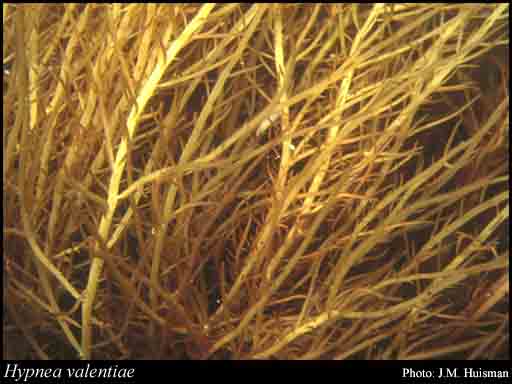- Reference
- Hist.Nat.Iles Canaries (Phytogr.) 161 (1841)
- Conservation Code
- Not threatened
- Naturalised Status
- Native to Western Australia
- Name Status
- Current

Scientific Description
Habit and structure. Thallus medium to dark red-brown, (5–)10–30 cm high, usually with a main percurrent axis and long percurrent lateral branches, much branched with irregular radial laterals becoming gradually shorter, main branches with numerous short, spinous, branchlets; all branches and branchlets directed upwards and not at right angles to parent branches; hamate branches absent. All branches terete, axes 1–1.5(–2) mm in diameter below, decreasing gradually to lesser branches 200–300 µm in diameter, branchlets basally 150–200 µm in diameter, tapering from their base to an acute apex. Attachment by small discoid haptera to stones and shells. Structure uniaxial with a protruding apical cell, axial filament conspicuous throughout, becoming 30–60 µm in diameter with cells L/D 4–10, surrounded by a medulla 2(–3) cells broad, inner cells ovoid and 40–100(–150) µm in diameter with numerous secondary pit-connections, and a small-celled cortex 1(–2) cells broad, outermost cells in an even layer, (5–)6–9 µm in diameter and L/D 1–2. Rhodoplasts discoid to elongate, several to numerous per cell, ribbon shaped in inner cells.
Reproduction. Sexual thalli probably dioecious. Carpogonial branches and early postfertilization stages not observed. Carposporophyte with a lax reticulum of elongate cells in filaments from several basal cells to upper pericarp cells, with smaller lateral cells producing clusters of small cells which cut off single, subspherical to ovoid, carposporangia 12–25 µm in diameter. Cystocarps mainly on the branchlets, sessile, globular, not or slightly basally constricted, 250–500(–700) µm in diameter, with a pericarp 2–4 cells thick, ostiole small and weakly defined. Spermatangia not observed.Tetrasporangia in swollen nemathecia around the lower part of lateral branchlets, basally pit-connected to inner cortical cells, ovoid, 25–60 µm long and 12–25 µm in diameter, zonately divided.
Distribution.Widely distributed in tropical and subtropical waters. In southern Australia, from Coffin Bay, S. Aust., to Crawfish Rock, Westernport Bay, Vic.
Habitat. H. valentiae occurs in sheltered localities but usually where there is current flow.
[After Womersley, Mar. Benthic Fl. Southern Australia IIIA: 445 (1994)]
Distribution
- IBRA Regions
- Esperance Plains, Geraldton Sandplains, Swan Coastal Plain.
- IBRA Subregions
- Geraldton Hills, Perth, Recherche.
- IMCRA Regions
- Abrolhos Islands, Central West Coast, Leeuwin-Naturaliste, WA South Coast.
- Local Government Areas (LGAs)
- Albany, Cockburn, Coorow, Dandaragan, East Fremantle, Esperance, Greater Geraldton, Irwin, Joondalup, Melville, Rockingham.